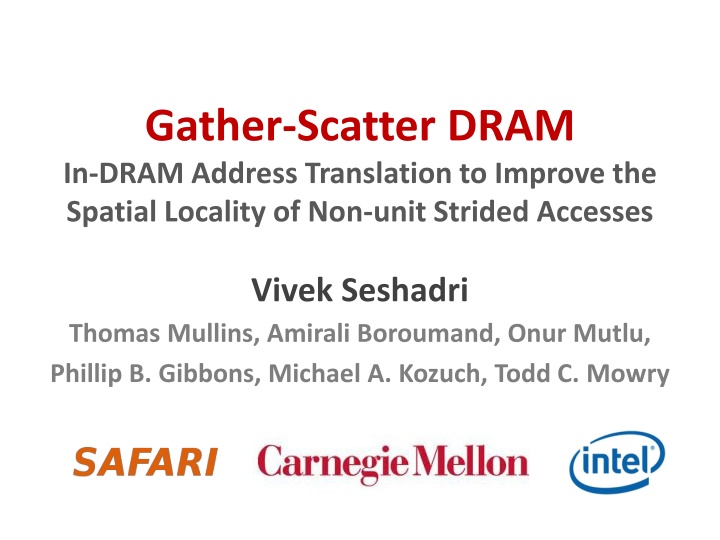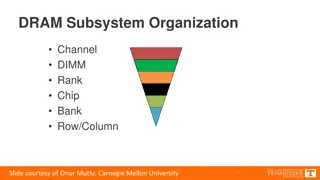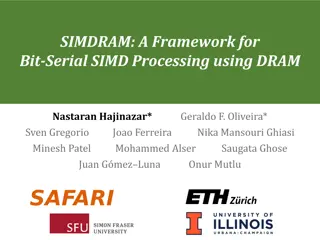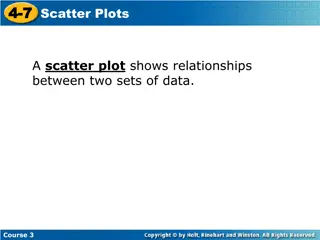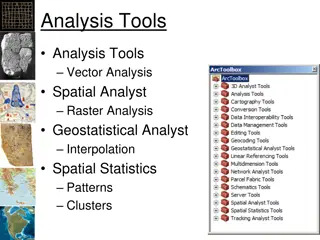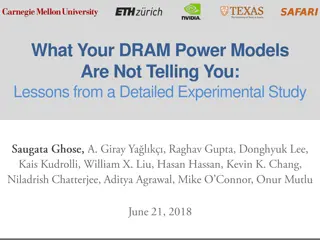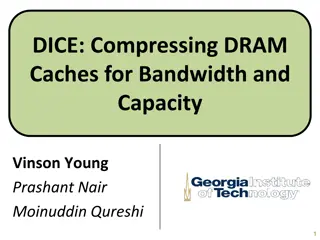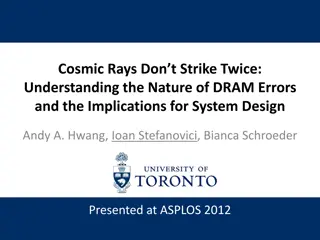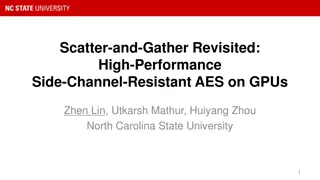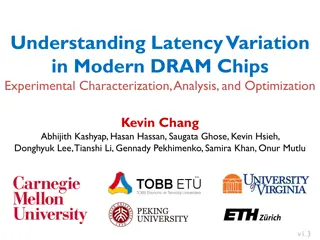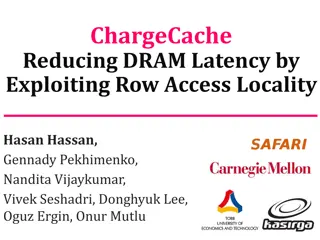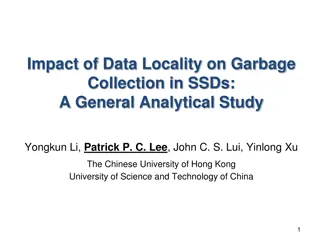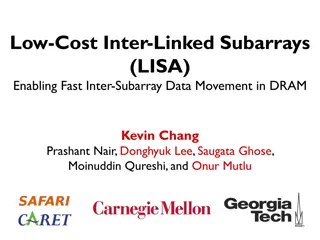Enhancing Spatial Locality with Gather-Scatter DRAM Address Translation
Proposal focuses on improving memory system efficiency for non-unit strided accesses by implementing Gather-Scatter DRAM to optimize memory bandwidth and cache utilization. It aims to address existing system shortcomings, eliminate inefficiencies, and enhance performance in various applications like in-memory databases and matrix multiplication.
Download Presentation

Please find below an Image/Link to download the presentation.
The content on the website is provided AS IS for your information and personal use only. It may not be sold, licensed, or shared on other websites without obtaining consent from the author.If you encounter any issues during the download, it is possible that the publisher has removed the file from their server.
You are allowed to download the files provided on this website for personal or commercial use, subject to the condition that they are used lawfully. All files are the property of their respective owners.
The content on the website is provided AS IS for your information and personal use only. It may not be sold, licensed, or shared on other websites without obtaining consent from the author.
E N D
Presentation Transcript
Gather-Scatter DRAM In-DRAM Address Translation to Improve the Spatial Locality of Non-unit Strided Accesses Vivek Seshadri Thomas Mullins, Amirali Boroumand, Onur Mutlu, Phillip B. Gibbons, Michael A. Kozuch, Todd C. Mowry
Executive summary Problem: Non-unit strided accesses Present in many applications In-efficient in cache-line-optimized memory systems Our Proposal: Gather-Scatter DRAM Gather/scatter values of strided access from multiple chips Ideal memory bandwidth/cache utilization for power-of-2 strides Requires very few changes to the DRAM module Results In-memory databases: the best of both row store and column store Matrix multiplication: Eliminates software gather for SIMD optimizations 2
Strided access pattern Field 1 Field 3 Record 1 Record 2 In-Memory Database Table Record n Physical layout of the data structure (row store) 3
Shortcomings of existing systems Data unnecessarily transferred on the memorychannel and stored in on- chipcache High latency Wasted bandwidth Wasted cache space High energy Cache Line 4
Prior approaches Improving efficiency of fine-grained memory accesses Impulse Memory Controller (HPCA 1999) Adaptive/Dynamic Granularity Memory System (ISCA 2011/12) Costly in a commodity system Modules that support fine-grained memory accesses E.g., mini-rank, threaded-memory module Sectored caches 5
Goal: Eliminate inefficiency Can we retrieve a only useful data? Gather-Scatter DRAM (Power-of-2 strides) Cache Line 6
DRAM modules have multiple chips All chips within a rank operate in unison! Two Challenges! ? READ addr Cache Line Data Cmd/Addr 7
Challenge 1: Chip conflicts Data of each cache line is spread across all the chips! Cache line 0 Cache line 1 Useful data mapped to only two chips! 8
Challenge 2: Shared address bus All chips share the same address bus! No flexibility for the memory controller to read different addresses from each chip! One address bus for each chip is costly! 9
Gather-Scatter DRAM Challenge 1: Minimizing chip conflicts Column-ID-based data shuffling (shuffle data of each cache line differently) Challenge 2: Shared address bus Pattern ID In-DRAM address translation (locally compute column address at each chip) 10
Column-ID-based data shuffling (implemented in the memory controller) Stage n enabled only if nth LSB of column ID is set Cache Line DRAM Column Address Stage 1 1 0 1 Stage 2 Stage 3 Chip 0 Chip 1 Chip 2 Chip 3 Chip 4 Chip 5 Chip 6 Chip 7 11
Effect of data shuffling After shuffling Before shuffling Chip conflicts Minimal chip conflicts! Chip 7 Chip 2 Chip 0 Chip 1 Chip 2 Chip 3 Chip 4 Chip 5 Chip 6 Chip 0 Chip 1 Chip 3 Chip 4 Chip 5 Chip 6 Chip 7 Col 0 Col 1 Col 2 Col 3 Can be retrieved in a single command 12
Gather-Scatter DRAM Challenge 1: Minimizing chip conflicts Column-ID-based data shuffling (shuffle data of each cache line differently) Challenge 2: Shared address bus Pattern ID In-DRAM address translation (locally compute the column address at each chip) 13
Per-chip column translation logic output address XOR READ addr, pattern AND chip ID cmd addr CTL cmd = READ/WRITE addr pattern pattern 14
Gather-Scatter DRAM (GS-DRAM) 32 values contiguously stored in DRAM (at the start of a DRAM row) read addr 0, pattern 0 (stride = 1, default operation) read addr 0, pattern 1 (stride = 2) read addr 0, pattern 3 (stride = 4) read addr 0, pattern 7 (stride = 8) 15
End-to-end system support for GS-DRAM Support for coherence of overlapping cache lines GS-DRAM New instructions: pattload/pattstore Pattern ID Cache Data Store Tag Store pattload reg, addr, patt CPU miss cacheline(addr), patt Memory controller DRAM column(addr), patt 16
Methodology Simulator Gem5 x86 simulator Use prefetch instruction to implement pattern load Cache hierarchy 32KB L1 D/I cache, 2MB shared L2 cache Main Memory: DDR3-1600, 1 channel, 1 rank, 8 banks Energy evaluations McPAT + DRAMPower Workloads In-memory databases Matrix multiplication 17
In-memory databases Layouts Workloads Row Store Transactions Column Store Analytics GS-DRAM Hybrid 18
Workload Database 1 table with million records Each record = 1 cache line Transactions Operate on a random record Varying number of read-only/write-only/read-write fields Analytics Sum of one/two columns Hybrid Transactions thread: random records with 1 read-only, 1 write-only Analytics thread: sum of one column 19
Transaction throughput and energy Row Store Column Store GS-DRAM 3X (mJ for 10000 trans.) (millions/second) Throughput Energy 20
Analytics performance and energy Row Store Column Store GS-DRAM Execution Time (mSec) 2X Energy (mJ) 21
Hybrid Transactions/Analytical Processing Row Store Column Store GS-DRAM 2 30 Execution Time (mSec) 1.8 25 1.6 (millions/second) Throughput 1.4 20 1.2 1 15 0.8 10 0.6 0.4 5 0.2 0 0 Transactions Analytics 22
Conclusion Problem: Non-unit strided accesses Present in many applications In-efficient in cache-line-optimized memory systems Our Proposal: Gather-Scatter DRAM Gather/scatter values of strided access from multiple chips Ideal memory bandwidth/cache utilization for power-of-2 strides Low DRAM Cost: Logic to perform two bitwise operations per chip Results In-memory databases: the best of both row store and column store Many more applications: scientific computation, key-value stores 23
Gather-Scatter DRAM In-DRAM Address Translation to Improve the Spatial Locality of Non-unit Strided Accesses Vivek Seshadri Thomas Mullins, Amirali Boroumand, Onur Mutlu, Phillip B. Gibbons, Michael A. Kozuch, Todd C. Mowry
Backup 25
Maintaining Cache Coherence Restrict each data structure to only two patterns Default pattern One additional strided pattern Additional invalidations on read-exclusive requests Cache controller generates list of cache lines overlapping with modified cache line Invalidates all overlapping cache lines 26
Hybrid Transactions/Analytical Processing Row Store Column Store GS-DRAM Transactions Analytics Execution Time (mSec) 21 (millions/second) Throughput 27
Transactions Results 10 Execution time for 10000 8 trans. 6 4 2 0 1-0-1 2-1-2 0-2-2 2-4-2 5-0-1 2-0-4 6-1-2 4-2-2 28
